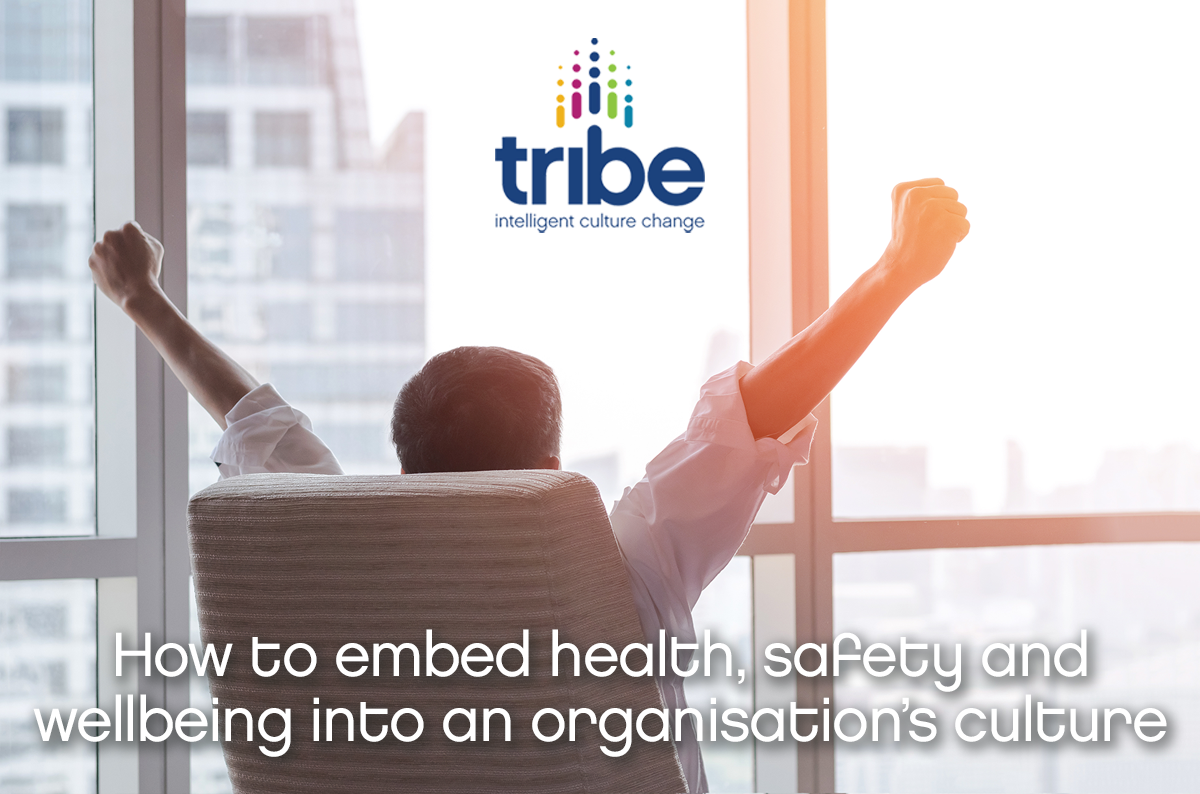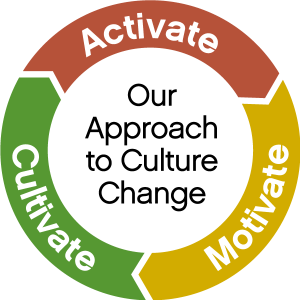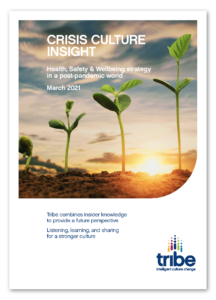
How to embed health, safety and wellbeing into an organisation’s culture
Embedding wellbeing into an organisational culture can be done – and sustained – but it isn’t a quick fix. And having published our latest Crisis Culture Insight report early this month, we know how vital it will be to integrate wellbeing into any post-pandemic Health, Safety and Wellbeing strategy.
We caught up with our Managing Director, Mark Ormond, and Lead Consultant, Ella NilaKanthi Ford, to find out how it can be done…
Kanthi, we’re all aware of how mental health and wellbeing at work has risen up the agenda as a result of Covid-19. Can you share some of your Crisis Culture Insight report findings on this topic?
Sure. Overall, we found that most of our report respondents reported concerns about declines in wellbeing. The main reasons being increased job demands, exhaustion, home-working/home schooling challenges and mental health struggles.
There were also concerns of burn out, unsustainable workloads, loneliness, and isolation as well as some people’s disengagement from workplace activities in the absence of a supportive community.
To try and support people, lots more open conversations are taking place but we wonder whether it’s enough. Managers are being asked to make time for people’s mental health but most – at the best of times – are ill equipped to ask the right questions and deal with the answers.
We’ve published an article recently on how managers can have better wellbeing conversations with employees and I encourage everyone to read this.
As stress and anxiety are becoming more widespread, many are experiencing far more extreme reactions than they would pre-Covid. Some people who are normally calm and considered are reacting more emotionally and with a lack of clarity leading to disagreements.
Senior leaders are overstretched in so many ways and some have been signed-off sick with depression and exhaustion.
It’s not all doom and gloom though as the report offers recommendations for the future and we’ve been working with clients to integrate wellbeing into all areas of the business. Mark can tell you more…
Mark, what’s the goal an organisation should be working towards?
The ideal scenario is when health, safety and wellbeing (HSW) is fully integrated within an organisation. If you talk to office or retail workers about their health and safety challenges, their issues will range from display screen equipment, to using ladders on the premises through to mental health and stress – something even higher on the agenda through Lockdown.
If you talk to the workforce out in the field they’ll tell to you about the physical risks they face, but they’ll also talk to you about fatigue, personal challenges that affect them at work and the pressures they feel in their role.
We’re seeing really positive momentum where organisations view the integration of HSW as part of the core delivery of their organisation.
Kanthi, can you provide an example of how can this be achieved in practice?
We’ve been working with a multinational telecoms company. They already had a HSW strategy in place, but it needed to be made more encompassing to include field, office and retail workers.
Often the HSW strategy will be totally divorced from overall business strategy. But when it’s connected to the company’s overarching strategy and values, we see far greater success as everything is more joined up. From the outset, with this client, we also made sure that Health, Safety AND wellbeing featured in their Safety Culture Assessments to start this consistency.
By integrating HSW in their culture, the client was positioning themselves as a corporate citizen with a HSW profile that encouraged people to work for them.
Mark, what steps did you go through with the client?
 We used our unique three-stage approach. We focus on activate, motivate and cultivate as they drive an organisation towards a ‘tipping point’ – that moment where behaviours start to line up. It’s when individuals are working towards a common, inspiring purpose and people do the right thing because it’s the right thing to do.
We used our unique three-stage approach. We focus on activate, motivate and cultivate as they drive an organisation towards a ‘tipping point’ – that moment where behaviours start to line up. It’s when individuals are working towards a common, inspiring purpose and people do the right thing because it’s the right thing to do.
Activate
We need to understand the baseline i.e. what’s happening now. Covering both the commercial and operational angles, we interviewed senior leaders and key stakeholders to understand their individual perspectives as well as the key enablers for success.
Having done this, we developed the vision for HSW, which was underpinned by key leadership principles. We also built a framework of activities to support and embed the strategy into the business behaviours.
Motivate
This is when we check the approach is fit for purpose. We developed a roadmap to embed the change featuring workshops and engagement. We designed a range of customised activities to leverage the client’s existing culture. We also advised our client on developing a steering committee of key influencers to ensure the implementing the HSW strategy would be aligned with the overall corporate strategy.
Cultivate
We then cultivate change for the long term with a continuous range of improvement programmes.
This work is carried out with a combination of the workforce – key opinion formers and influencers, front-line workforce and middle managers. When shifting an organisation’s culture, you’ve got to:
- Ensure HSW is consistent across the business
- Build on existing leadership structures
- Ignite safety behaviours at a grassroots level
- Win hearts and minds.
Kanthi, where does an organisation go from here?
It’s a long journey. ‘Culture’ can be boiled down to ‘the way we do things here’ and once it’s been shifted, it can take time to maintain momentum and ensure sustained behavioural change. So we also use the science of engagement and communications to create a range of ‘sticky’ activities to ‘nudge’ appropriate behaviours. And there are many ways of achieving this.
For Biffa, we created a pact for safety called ‘Safer Together’. It was about winning hearts and minds and gaining buy-in from the workforce. We gleaned insights from the research, pulled together the key themes and, out of that, identified simple behaviours and words. Underlying it was a principle that everyone in the workforce had permission to call-out bad behaviour.
To support and strengthen the culture at Carnival Cruises, we worked with them to create a set of behavioural golden rules – a work code that everyone could engage with. We linked it all to a universal ‘heart’ gesture which became the centre of a communication campaign to raise awareness. Read more about this Client Story.
The best comment I’ve received from our telecoms client was: “We never used to talk about wellbeing but now it forms part of every call”. That’s exactly where an organisation needs to be heading.
To discuss how Tribe can help embed wellbeing into your organisational culture, get in touch. You can also download our Crisis Culture Insight report to support your post-pandemic planning.
About Kanthi (Ella NilaKanthi) Ford
Lead Consultant
Kanthi is a highly skilled and experienced leadership coach, culture and behaviour expert. She has a fantastic ability to engage people and has delivered many complex culture change programmes for Tribe clients. An acclaimed author, her most recent book is called ‘Bias Impacts: How Culture and Diversity Affects the Leadership Journey’.
Specialisms: Diversity, equity and inclusion, Leadership and employee engagement, Behaviour change psychology, Global delivery
Industry experience: Aviation and Aerospace, Agri-business, Agri-food, Banking and Fintech, Construction, Energy (renewables, oil, gas, hydrogen and shale), Facilities, Healthcare, Manufacturing, Pharmaceutical, Rail, Retail, Technology, Telecoms, Utilities
About Ella NilaKanthi Ford
Lead Consultant
Kanthi is a highly skilled and experienced leadership coach, culture and behaviour expert. She has a fantastic ability to engage people and has delivered many complex culture change programmes for Tribe clients. An acclaimed author, her most recent book is called ‘Bias Impacts: How Culture and Diversity Affects the Leadership Journey’.
Specialisms: Diversity, equity and inclusion, Leadership and employee engagement, Behaviour change psychology, Global delivery
Industry experience: Aviation and Aerospace, Agri-business, Agri-food, Banking and Fintech, Construction, Energy (renewables, oil, gas, hydrogen and shale), Facilities, Healthcare, Manufacturing, Pharmaceutical, Rail, Retail, Technology, Telecoms, Utilities




